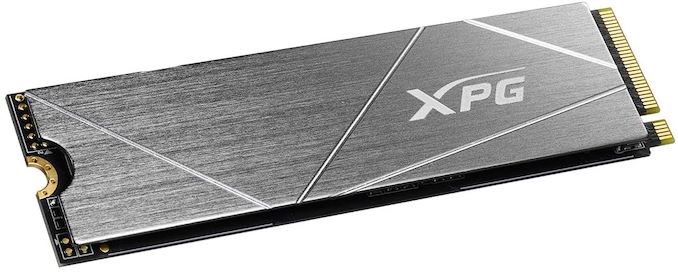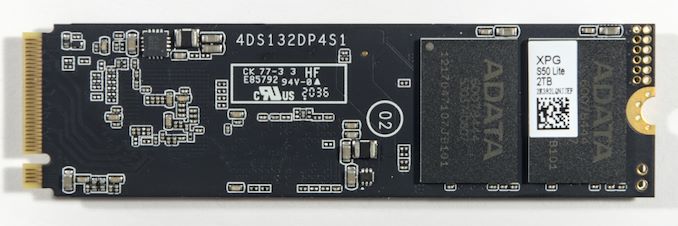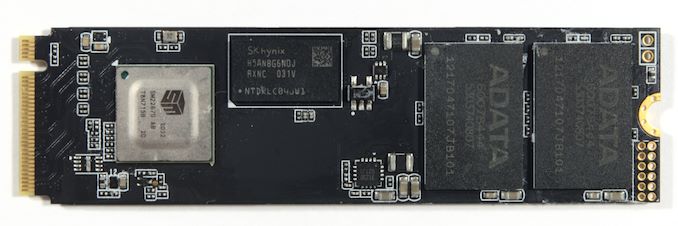The ADATA GAMMIX S50 Lite 2TB SSD Review: Mainstream PCIe Gen4
by Billy Tallis on April 30, 2021 8:00 AM EST
The roll-out of PCIe 4.0 support to consumer NVMe SSDs has been a long, drawn-out process so far, but it is progressing. Two waves of high-end SSDs have now hit the market, and last year we saw several brands introduce QLC-based SSDs using the now-outdated first-wave Gen4 SSD controller from Phison. More recently, PCIe 4.0 support has arrived for the mainstream mid-range market segment thanks to the ADATA XPG Gammix S50 Lite, based on the Silicon Motion SM2267 controller and TLC NAND flash memory.
The ADATA S50 Lite uses Silicon Motion's first PCie 4.0 SSD controller: the SM2267. Opting to start small, Silicon Motion has launched their mainstream SSD controller first, while their upcoming (overdue?) SM2264 will eventually be filling the high-end role.
To that end, the SM2267 serves Silicon Motion's lineup as a smaller, cheaper design aimed at mainstream consumer use cases. To accomplish this, Silicon Motion has built the SM2267 on a tried-and-true (and cheap) 28nm process and equipped the controller with 4 NAND channels, as opposed to the 12nm (or smaller) 8-channel controllers that are used in the latest high-end drives. This does limit maximum performance, but it also helps to keep costs in check, something that's especially useful during the current chip crunch.
Intel's recently-launched third generation QLC SSD (the Intel SSD 670p) uses a close relative of this controller; the SM2265 is an Intel-commissioned derivative of the SM2267 that lacks PCIe 4.0 support, but is otherwise identical in all the important ways. As we'll see from the S50 Lite's performance, the Intel 670p isn't missing out on much without that Gen4 support.
As for the subject of today's review, the ADATA XPG Gammix S50 Lite and its SM2267 controller is part of a growing trend of mainstream NVMe SSDs moving to 4-channel controllers rather than 8 channels. The capacity of individual NAND flash memory dies has grown to the point that an 8-channel controller is not necessary to get 2TB of flash connected, and the IO speed of recent generations of NAND flash is fast enough that a newer four-channel controller can match the performance of older 8-channel designs. This was first demonstrated to great effect by the SK hynix Gold P31. On paper, the Gammix S50 Lite promises more or less the same thing: performance that matches or slightly exceeds what we see from high-end PCIe Gen3 SSDs also using TLC NAND, despite working with half as many NAND channels.
| ADATA XPG Gammix S50 Lite Specifications | |||||
| Capacity | 512 GB | 1 TB | 2 TB | ||
| Form Factor | M.2 2280 double-sided with heatsink | ||||
| Interface | PCIe 4 x4, NVMe 1.4 | ||||
| Controller | Silicon Motion SM2267 | ||||
| NAND Flash | Intel/Micron 96L TLC | ||||
| DRAM | DDR4 | ||||
| Sequential Read (MB/s) | 3800 | 3900 | |||
| Sequential Write (MB/s) | 2800 | 3200 | |||
| Random Read IOPS (4kB) | 191k | 380k | 490k | ||
| Random Write IOPS (4kB) | 510k | 540k | |||
| Warranty | 5 years | ||||
| Write Endurance | 370 TB 0.4 DWPD |
740 TB 0.4 DWPD |
1480 TB 0.4 DWPD |
||
| Retail Price | $139.99 (14¢/GB) |
$235.99 (12¢/GB) |
|||
ADATA equips the S50 Lite with a fairly thick heatspreader, and like most of their Gammix SSDs, that heatspreader comes already attached to the drive rather than packaged separately as with their SX series drives. Instead of using their typical thermal paste, this heatspreader is attached with what is by far the most tenacious thermal tape we've ever encountered. It is reinforced with a tight-woven stiff fabric and the adhesive was strong enough that removing the heatspreader without permanently damaging the drive required copious use of solvents instead of just a bit of gentle prying.
So while we had originally speculated that the SM2267 controller might allow the S50 Lite to be the first Gen4 SSD suitable for laptop usage (hoping for similar power efficiency to the SK hynix Gold P31), this heatspreader plus the double-sided design means the S50 Lite will be a challenge to fit into some notebooks.
The SM2267 controller actually has a slightly higher pin count than the older 8-channel SM2262(EN) controllers, but the SM2267 uses denser packaging to fit in the same footprint as their earlier 4-channel SM2263 controller. The resulting PCB layout is not at all crowded, and could have easily been made into a single-sided design like the Intel 670p, had ADATA wanted to stack 16 NAND dies per package. Any future drives that use the DRAMless SM2267XT variant certainly should be single-sided.
Our 2TB S50 Lite sample is equipped with 1GB of DDR4 DRAM—half as much as we would typically expect from a mainstream or high-end SSD. As the high-end has moved on to PCIe Gen4, we have seen an increasing number of mid-range or low-end NVMe SSDs cut back from the usual 1GB per 1TB ratio of DRAM to NAND, and with the S50 Lite that trend has crossed over to Gen4. Having half or a fourth of the usual DRAM is nowhere near as serious a handicap as an entirely DRAMless SSD design, and will generally only make a difference for very storage-intense usage with heavy multitasking—workloads that are a bit beyond the intended use case for a drive like the S50 Lite.
Also noteworthy about the S50 Lite is that ADATA announced and published specs for a 512GB model, but we've only seen the 1TB and 2TB models hit the market.
The Competition
ADATA's original Gammix S50 was a Phison E16 drive: their first flagship Gen4 drive and part of the first wave of consumer Gen4 SSDs. That has since been superseded by the Gammix S70, and the S50 Lite slots into a lower position in their product stack. Standing in for the various Phison E16 TLC drives, we have test results from the Seagate FireCuda 520. We also have the Corsair MP600 CORE representing the Phison E16 QLC drive family.
Other PCIe Gen4 drives in this review include the WD Black SN850 and Samsung 980 PRO—both high-end models that are significantly more expensive.
The rest of the drives included in this review are a variety of more mainstream PCIe Gen3 SSDs and some relatively low-end NVMe options. Highlights include the Intel 670p (almost the same controller, but with QLC), the HP EX950 and Kingston KC2500 using the previous-generation SM2262EN controller, and Microcenter's Inland Premium representing the current crop of Phison E12S drives with TLC NAND and a reduced DRAM ratio.

















93 Comments
View All Comments
Dizoja86 - Saturday, May 1, 2021 - link
I was also confused about that. The price seems fair for the performance.Dizoja86 - Saturday, May 1, 2021 - link
Really hoping to see that S70 review soon. From the SSD recommendations for this month, it sounds like it's in the works.Billy Tallis - Saturday, May 1, 2021 - link
I'm currently wrapping up testing of the most recent Innogrit firmware available. Over the weekend I'll be re-testing the 980 PRO with Samsung's newest firmware. Once those tests are complete, I plan to write up my Phison E18 review first, then the ADATA S70.Scour - Sunday, May 2, 2021 - link
Would be nice :)Dug - Wednesday, May 5, 2021 - link
From looking at others like storage review, I wouldn't even be looking at that drive.Nexing - Saturday, May 1, 2021 - link
'we had originally speculated that the SM2267 controller might allow the S50 Lite to be the first Gen4 SSD suitable for laptop usage (hoping for similar power efficiency to the SK hynix Gold P31)'What about?
Sabrent 1TB Rocket 4 Plus NVMe 4.0 Gen4 PCIe M.2 Internal SSD Extreme Performance Solid State Drive (SB-RKT4P-1TB)
Billy Tallis - Saturday, May 1, 2021 - link
The Rocket 4 Plus is a Phison E18 drive. That's an 8-channel controller designed for maximum performance. That kind of goal usually leads to mediocre power efficiency at best. And our testing shows that the E18 doesn't even have great efficiency among current top of the line Gen4 controllers. For example, an E18 drive against the WD Black SN850 loses in all but one of the efficiency scores: https://www.anandtech.com/bench/product/2783?vs=27...And against the SK hynix Gold P31, the E18 drive loses very badly on efficiency, with the P31 typically getting somewhere around 3x better performance per Watt: https://www.anandtech.com/bench/product/2783?vs=27...
You might be able to run an E18 drive in a laptop, but the extra performance isn't going to make anything feel noticeably faster, and if you have a heavy storage workload that might come close to making use of the drive's theoretical performance, then its poor efficiency will start to have an impact on battery life.
Scour - Sunday, May 2, 2021 - link
I think thermal throttling in laptops could be a big problem if using high performance NVME-SSDsTheinsanegamerN - Monday, May 3, 2021 - link
Well duh.Linustechtips12#6900xt - Monday, May 3, 2021 - link
laptops have one big issue, thermal performance, and we have seen let's just call "optimistic" ways of cooling down our silicon chips there will always be problems with thermals and desktops will always be faster just because of thermals period simple as that, I do realize this is very like probably not right in the sense desktops will always outperform laptops but for the foreseeable future, I believe it to be true.